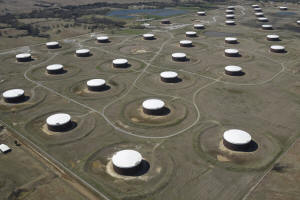Oil soars 3% to 7-yr highs on Ukraine jitters, tight supplies
 Send a link to a friend
Send a link to a friend
 [February 12, 2022] By
Arathy Somasekhar [February 12, 2022] By
Arathy Somasekhar
(Reuters) - Oil prices ended 3% higher on
Friday at fresh seven-year highs as escalating fears of an invasion of
Ukraine by Russia, a top energy producer, added to concerns over tight
global crude supplies.
Russia has massed enough troops near Ukraine to launch a major invasion,
Washington said, as it urged all U.S. citizens to leave the country
within 48 hours.
Britain also advised its nationals to leave Ukraine as Prime Minister
Boris Johnson impressed the need for NATO allies to make it absolutely
clear that there will be a heavy package of economic sanctions ready to
go, should Russia invade Ukraine.
Brent crude futures settled $3.03, or 3.3%, higher at $94.44 a barrel,
while U.S. West Texas Intermediate crude rose $3.22, or 3.6%, to $93.10
a barrel.
Both benchmarks touched their highest since late 2014, surpassing the
highs hit on Monday, and posted their eighth consecutive week of gains
on growing concerns about global supplies as demand recovers from the
coronavirus pandemic.
Trading volumes spiked in the last hour of trading, with volumes for
global benchmark Brent climbing to their highest in more than two
months.

"The market doesn't want to be short going into the weekend ... if an
invasion appears to be imminent and you know that there will be
retaliatory sanction that will result in a disruption in natural gas and
oil supplies," Andrew Lipow, president of Lipow Oil Associates in
Houston.
The International Energy Agency raised its 2022 demand forecast and
expects global demand to expand by 3.2 million barrels per day (bpd)
this year, reaching an all-time record 100.6 million bpd. [IEA/M]
[to top of second column] |

Crude oil storage tanks are seen from above at the Cushing oil hub,
in Cushing, Oklahoma, March 24, 2016. Picture taken March 24, 2016.
REUTERS/Nick Oxford

The energy watchdog's report follows the Organization of the Petroleum Exporting
Countries' warning earlier this week that world oil demand might rise even more
steeply this year on a strong post-pandemic economic recovery. [OPEC/M]
The IEA added that Saudi Arabia and the United Arab Emirates could help to calm
volatile oil markets if they pumped more crude, adding that the OPEC+ alliance
produced 900,000 bpd below target in January.
The two OPEC producers have the most spare production capacity and could help to
relieve dwindling global oil inventories that have been among factors pushing
prices towards $100 a barrel, deepening inflation worldwide.
The Biden administration responded to high prices by again stating this week
that it has been talking with large producers about more output, as well as the
possibility of additional strategic releases from large consumers, as it did
late last year.
Indirect U.S.-Iran nuclear talks resumed this week after a 10-day break. A deal
could see the lifting of sanctions on Iranian oil and ease supply tightness.
In the United States, drillers added the most oil rigs in a week in four years,
with the rig count, an indicator of future production, rising 19 to 516, its
highest since April 2020, energy services firm Baker Hughes Co said.
(Additional reporting by Ahmad Ghaddar and Ron Bousso in London; Emily Chow in
Beijing; Editing by Marguerita Choy and David Gregorio)
[© 2022 Thomson Reuters. All rights
reserved.]This material may not be published,
broadcast, rewritten or redistributed.
Thompson Reuters is solely responsible for this content. |